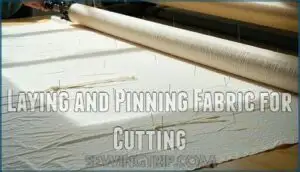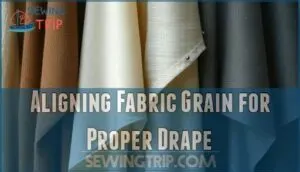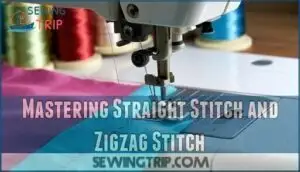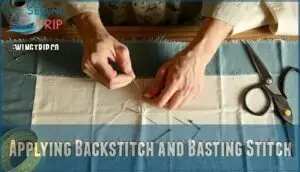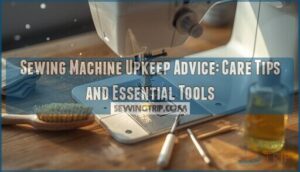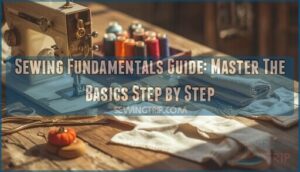This site is supported by our readers. We may earn a commission, at no cost to you, if you purchase through links.
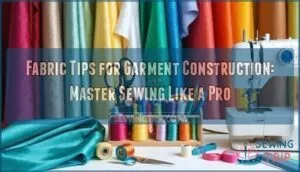 In the context of fabric tips for garment construction, you’ll want to pick fabric that matches your project’s needs—think weight, stretch, and how it drapes.
In the context of fabric tips for garment construction, you’ll want to pick fabric that matches your project’s needs—think weight, stretch, and how it drapes.
Always check the fabric grain; it’s the backbone for how your clothes will hang.
Use sharp scissors, pin carefully, and cut with confidence—no one wants a wobbly hem.
Test your stitches on scraps first, because every fabric has its quirks. Don’t forget to finish your seams for a garment that can handle life’s twists and turns.
Stick around—there’s a whole toolkit of smart tricks waiting to make your sewing journey smoother.
Table Of Contents
Key Takeaways
- Always match your fabric’s weight, stretch, and breathability to your project for the best fit and comfort.
- Check and align the fabric grain before cutting to prevent twisting seams and poor drape.
- Use sharp cutting tools and test your stitches on scraps to avoid fraying and ensure clean, strong seams.
- Finish your seams properly to keep your garment durable and looking polished after repeated wear.
Fabric Selection Basics
When you pick fabric for your project, you’ll want to match its weight, stretch, and breathability to your garment’s needs.
Choose fabric with the right weight, stretch, and breathability to make sure your garment looks and feels just right.
Understanding how grain and drape affect construction helps you achieve a professional finish every time.
Evaluating Fabric Weight and Stretch
Before cutting your first piece, you’ll want to assess fabric weight since it determines needle size and stitch length.
Heavy woven fabrics need different handling than lightweight knit types.
Test stretch recovery by pulling the fabric bias – quality stretch fabrics bounce back quickly.
Weight impact affects fabric drape substantially, while blended fabrics combine properties from different fiber types, creating unique construction challenges, including how fabric weight and stretch recovery impact the overall project.
Assessing Fabric Breathability and Durability
When choosing fabric, check air permeability and abrasion resistance to balance comfort and long wear.
Fiber content and weave structure shape how breathable fabrics feel and how durable garments stay.
Use testing methods like the upright cup or sweating hot plate to measure fabric properties.
Always consider fabric durability—after all, nobody wants their masterpiece falling apart after one wash.
To guarantee garments meet expectations, manufacturers often conduct thorough fabric inspection to ensure high-quality standards.
Considering Fabric Grain and Drape
Once you’ve checked breathability and durability, it’s time to look at fabric grain and drape.
Pay attention to grain alignment—cutting off-grain can twist your seams.
Woven vs knit fabrics behave differently, so match drape qualities to your pattern.
For bias cuts, fabric properties change, affecting fit.
Pattern matching also depends on understanding fabric grain and drape during fabric selection.
Pattern Making Essentials
You’ll need to master pattern making to guarantee your garment fits well and looks polished, so pay close attention to how fabric properties like grain and stretch affect your design.
Whether you use classic paper patterns or digital tools, accurate pattern pieces and proper alignment with the fabric’s characteristics are key to professional results.
Creating Accurate Pattern Pieces
Blueprints matter—creating accurate pattern pieces is your secret weapon for pro-level sewing. Focus on pattern drafting, grain alignment, and seam allowance for best results.
Use muslin testing to catch fit issues before precision cutting your final fabric. Remember, pattern making is where your garment’s journey begins.
Drafting basic blocks is a foundational step.
- Mark seam allowances
- Check grain alignment
- Adjust patterns as needed
- Test with muslin
- Cut fabric precisely
Understanding Fabric Properties and Behavior
Before diving into pattern making, get to know your fabric’s quirks—fiber content and weave structure shape everything from fabric manipulation to fabric care.
Every fabric tells a story—learn its behavior before you start cutting and stitching for smoother sewing success.
Always do fabric testing: check for shrinkage assessment and colorfastness behavior.
Different fabric types respond uniquely to handling, so align pattern pieces with the fabric grain for best results.
Smart fabric selection means fewer surprises later.
Utilizing Traditional and Modern Pattern Making Methods
Whether you’re a fan of Flat Pattern drafting or prefer hands-on Draping Techniques, mastering pattern making means blending old and new.
Traditional methods use rulers and muslin mockups for accuracy, while Digital Patterning and CAD systems bring speed and precision.
Pattern Grading expands size options, and modern technology lets you test designs virtually—saving time, fabric, and frustration.
Accurate patterns are essential, as they translate a designer’s idea into wearable garment designs.
Cutting Techniques Matter
When you cut fabric, every step counts, from laying it flat and pinning pattern pieces securely to making sure the grain aligns for a smooth drape.
Using sharp scissors or a rotary cutter guarantees clean edges, setting the foundation for accurate assembly and a professional finish.
Laying and Pinning Fabric for Cutting
Once your pattern making is complete, it’s time to lay out your fabric for cutting.
Smooth the fabric flat, checking for wrinkles and aligning selvages.
Use pattern weights or precise Pinning Techniques to keep pieces steady—no chasing runaway corners.
Careful Fabric Alignment and Grain Matching help with Cutting Precision.
Always double-check placement before cutting fabric to support smart fabric selection and sewing techniques.
These tools can act as reliable pattern weights during layout.
Aligning Fabric Grain for Proper Drape
Once you’ve pinned your fabric, pay close attention to grain alignment. The grainline importance can’t be overstated—misaligned fabric grain leads to fabric distortion and poor drape.
For woven vs knit fabrics, check the grain before cutting. Use bias cutting for added stretch or unique drape.
Evaluate drape by gently lifting the fabric. Smart fabric selection and these fabric tips guarantee lasting results.
Using Sharp Cutting Tools for Clean Edges
For clean, professional edges, always reach for sharp fabric shears or rotary cutters and use a cutting mat to protect your surfaces.
Blade maintenance is key—dull blades snag and fray fabric, undermining precision cutting.
Ergonomic cutting tools save your wrists during long sessions.
Rotary cutters guarantee accurate cuts.
For high-tech projects, automated cutting and laser cutting offer laser precision that’s tough to beat.
Sewing and Finishing Garments
You’ll need to master essential stitches and seam finishes to guarantee your garments hold up through wear and washing.
Focus on using the right techniques for each fabric, since strong seams and clean edges make all the difference in professional-looking results.
Mastering Straight Stitch and Zigzag Stitch
Learning the ropes with straight and zigzag stitches sets the stage for sewing success.
Adjust stitch length for strong seams, and tweak thread tension for smooth results. Try different needle types for various fabrics. Use proper fabric feed to prevent puckering.
Seam finishes matter—practice these sewing techniques for crisp, professional results, especially when sewing for beginners.
- Adjust stitch length for fabric type
- Balance thread tension for smooth stitches
- Choose correct needle types for your fabric
- Maintain even fabric feed to avoid puckering
- Use seam finishes for polished edges and to ensure sewing success
Applying Backstitch and Basting Stitch
When reinforcing seams, try the backstitch for strong, hand-sewn lines—great for areas needing extra durability.
For temporary holding, the basting stitch is your go-to, especially when testing fit or working with tricky fabric types.
Adjust your stitch length depending on the sewing technique and fabric. These simple sewing tips make your stitches precise, reliable, and easy to remove when needed, using techniques like the backstitch.
Finishing Seams and Edges for Durability
A solid seam finish keeps your garment from unraveling and helps it last.
To get professional results, focus on these steps:
- Choose the right edge treatments—think serger options or clever binding methods.
- Match seam finishes and stitch types with your fabric, paying attention to seam allowances.
Finish up with pressing techniques that set the seams, preventing puckering and stretching. A variety of options exist for professional-looking seam finishes, which can help achieve a professional-looking finish and ensure the garment lasts, with the right seam finishes.
Advanced Garment Construction
When you’re ready to take your skills further, advanced garment construction techniques help you shape, reinforce, and finish garments for a polished result.
You’ll use tools like interfacing, create features such as darts and pleats, and install closures to guarantee your projects are both durable and functional.
Using Interfacing and Stabilizers for Structure
When you want crisp collars or sharp cuffs, interfacing types and stabilizer uses are your best friends.
Choose fusible options for quick structure enhancement, or try sew-in interfacing for heat-sensitive fabrics.
Proper fabric preparation guarantees interfacing fabrics bond well, giving garments lasting shape.
Many use this type of material for garment construction.
Here’s a quick cheat sheet:
| Fabric Tip | Why It Matters |
|---|---|
| Fusible Interfacing | Fast, seamless structure |
| Sew-in Interfacing | Best for delicate fabrics |
| Cut-away Stabilizer | Permanent embroidery support |
| Water-soluble | Leaves no residue |
| Match Weight | Prevents stiffness or sag |
Applying Darts, Tucks, and Pleats for Shaping
After adding structure with interfacing, it’s time to shape your garment. Darts, tucks, and pleats turn flat fabric into a customized fit. Nail Dart Placement, explore Pleat Styles, and experiment with Tuck Variations for creative Volume Control.
Remember:
- Mark shaping lines precisely
- Press each fold for crisp results
- Match shaping principles to fabric tips
- Test techniques on scraps first
For a perfect fit, consider adjusting dress bust darts on your patterns to achieve a perfect fit with proper techniques.
Installing Closures and Embellishments for Functionality
After shaping your garment with darts and pleats, it’s time to focus on closures and embellishments.
Choose Zipper Types that suit your fabric’s weight, and mark Button Placement carefully for a neat finish.
Reinforce closures—like buttons, buttonholes, or magnetic snaps—to withstand daily wear.
Secure embellishments tightly, ensuring Embellishment Security and Functional Detailing, so everything stays put, wash after wash.
Frequently Asked Questions (FAQs)
How do I use a French curve for garment construction?
Curves create clean contours—grab your French curve, line it up with armholes, necklines, or hip curves on your pattern, and trace smoothly.
Don’t eyeball it; this tool’s your shortcut to consistent, professional results.
How to make a garment?
Start by choosing your pattern and fabric, then pre-wash and press the material.
Cut pieces carefully, align with the grain, pin and sew using the right stitch.
Finish seams, add closures, and give everything a final press, ensuring complete concepts are followed for a polished result.
How do I learn clothing construction?
Jump in with both feet—take a beginner sewing class, watch online tutorials, and practice by making simple projects.
Pay attention to pattern instructions, fabric choice, and finishing techniques.
Mistakes teach you more than perfect stitches ever will, and this understanding is crucial for improvement, as it helps you learn from your mistakes.
How do I learn to sew a garment?
Pick a simple pattern, gather your supplies, and read instructions twice—trust me, it helps.
Cut carefully, pin pieces with patience, and sew slowly.
Press seams as you go, and don’t sweat mistakes—they’re just part of learning.
How to make a good garment pattern?
Imagine blueprinting a spaceship but for your body—measure accurately, add seam allowances, and align pieces with the fabric grain.
Double-check fit by testing with muslin, then tweak details until your pattern matches your vision and fit goals, ensuring a perfect fit.
What makes a garment a good fit?
A garment fits well when it follows your body’s shape without pulling or sagging, lets you move comfortably, and sits smoothly at key points like shoulders, waist, and hips—think of it as a custom handshake, not a wrestling match.
How do you prevent fabric from shrinking after sewing?
Pre-wash, press, and prepare your fabric before you sew—think of it as giving your material a spa day.
This helps sidestep surprise shrinking later, so your finished piece keeps its shape and size.
What’s the best way to store leftover fabric?
Roll your fabric instead of folding it to dodge hard creases, then stash it in a cool, dry place.
Clear bins or labeled bags help you spot what you need, saving you from a wild fabric treasure hunt.
How do you remove stubborn creases from fabric?
Spritz water, set your iron to the right temperature, and press with steady pressure—don’t slide.
For stubborn creases, use a damp cloth as a buffer, letting steam and heat work their magic without scorching the fabric.
Which fabrics are most prone to pilling?
You’ll find polyester, acrylic, and blends with short, loose fibers tend to pill the most.
When those fibers rub together, little balls form.
Stick with tightly woven cotton or linen if you want to dodge the fuzz attack.
Conclusion
Just as every stitch counts, your attention to fabric tips for garment construction shapes the final result.
By choosing the right material, respecting grain lines, and using sharp tools, you set yourself up for success.
Test stitches on scraps, finish your seams, and don’t rush the details.
These habits make your garments last and look polished.
Keep practicing, stay curious, and let each project teach you something new.
With these fabric tips for garment construction, you’ll sew like a pro.
- https://www.studysmarter.co.uk/explanations/art-and-design/fashion/garment-construction/
- https://issuu.com/foxchapel/docs/978-1-947163-74-4_single_high_flip_web
- https://webserver.crooksville.k12.oh.us/HomePages/book-search/T67738/UltimateGuideToSewing.pdf
- https://audaces.com/en/blog/pattern-making
- https://www.cliffsnotes.com/study-notes/27771043


